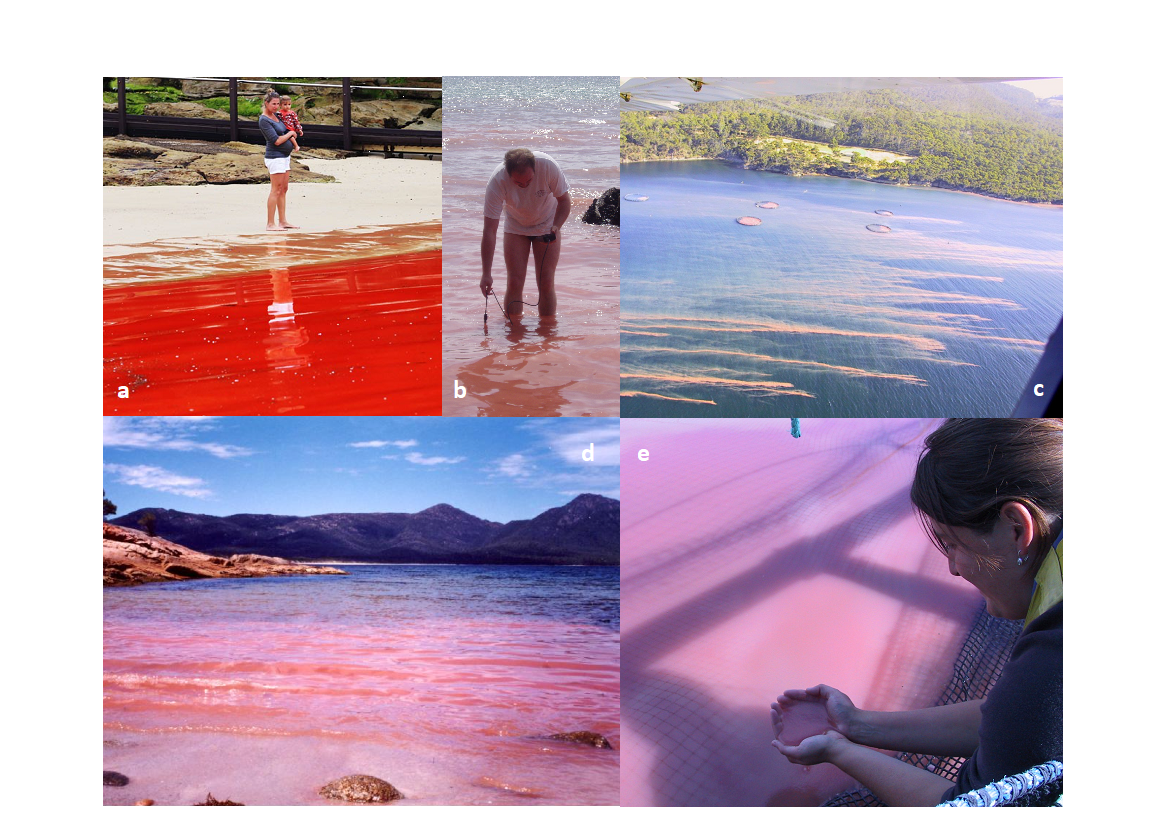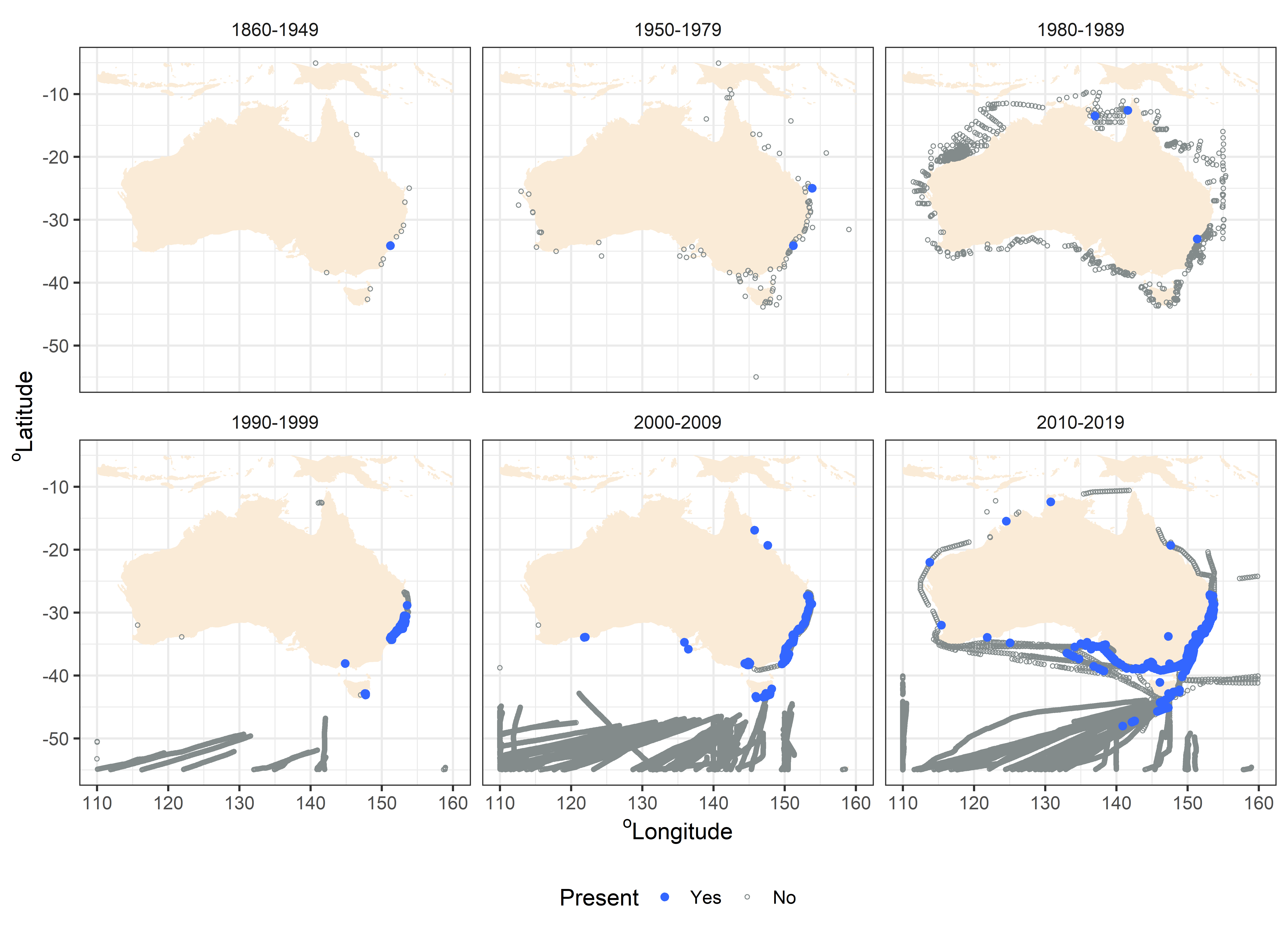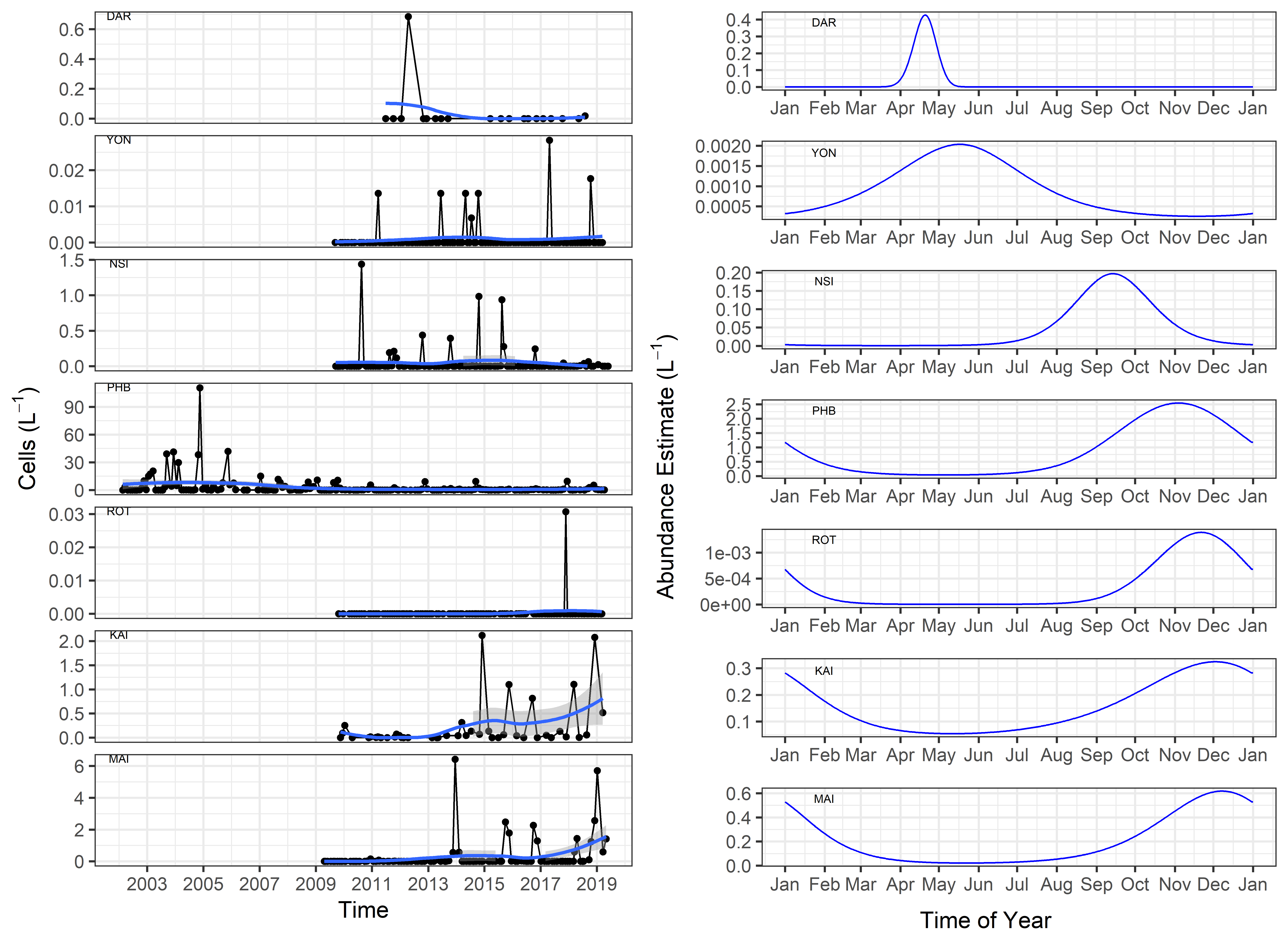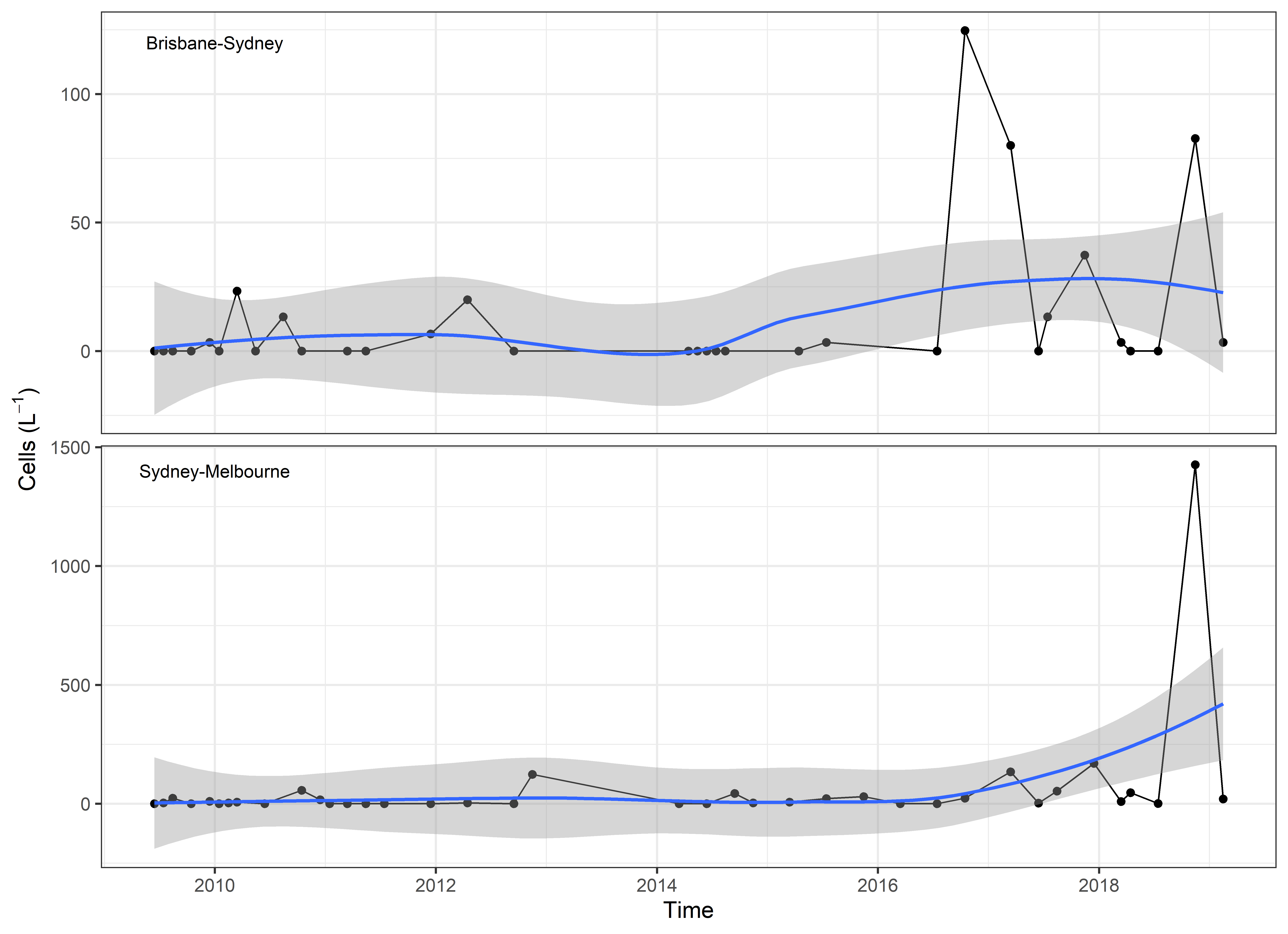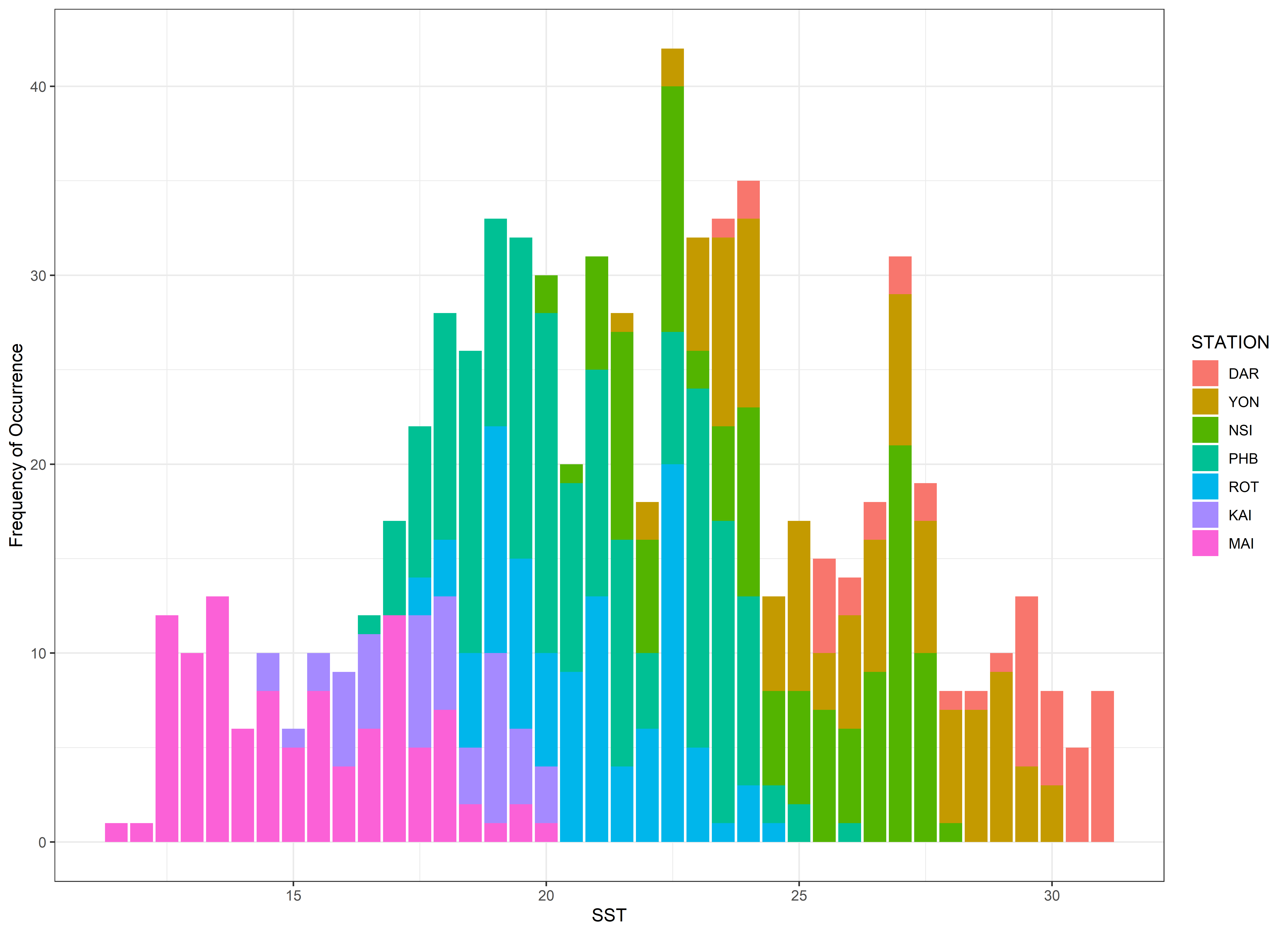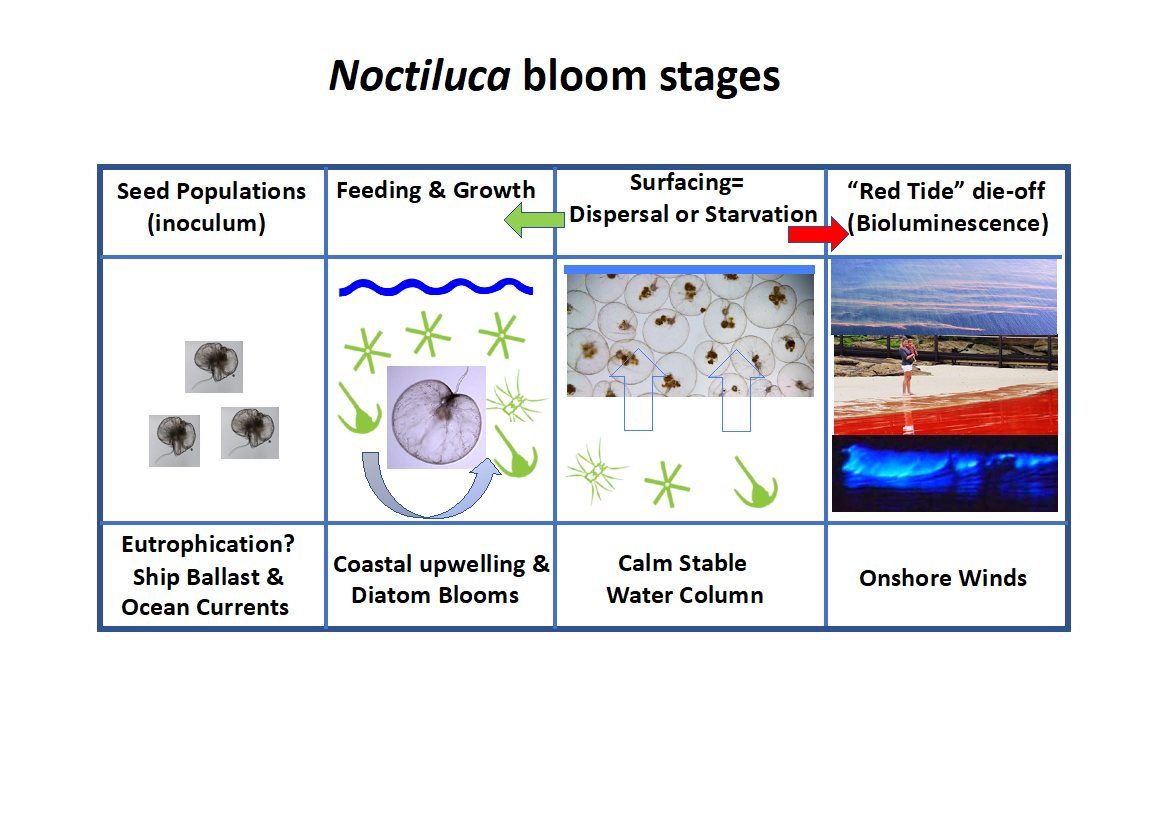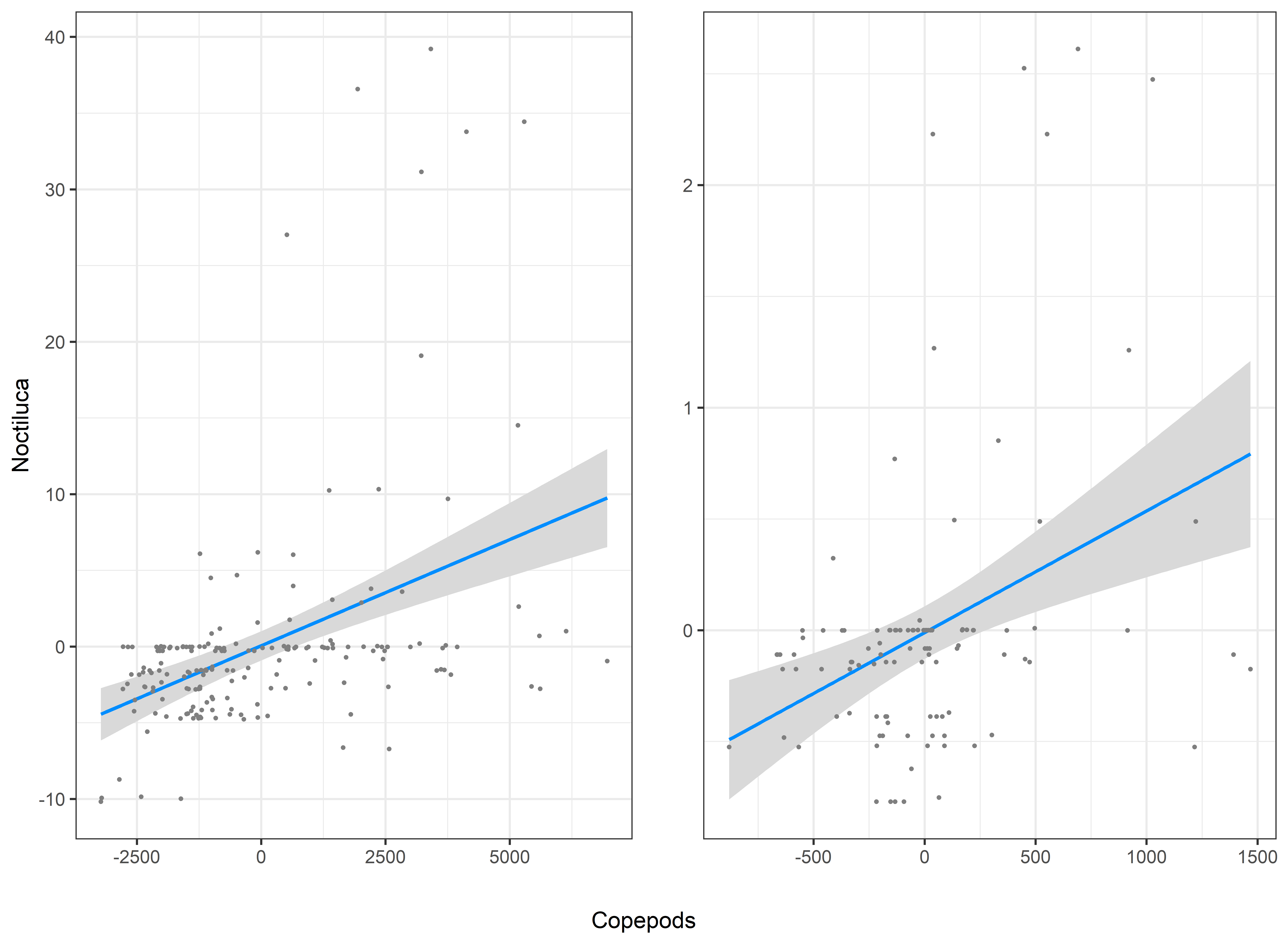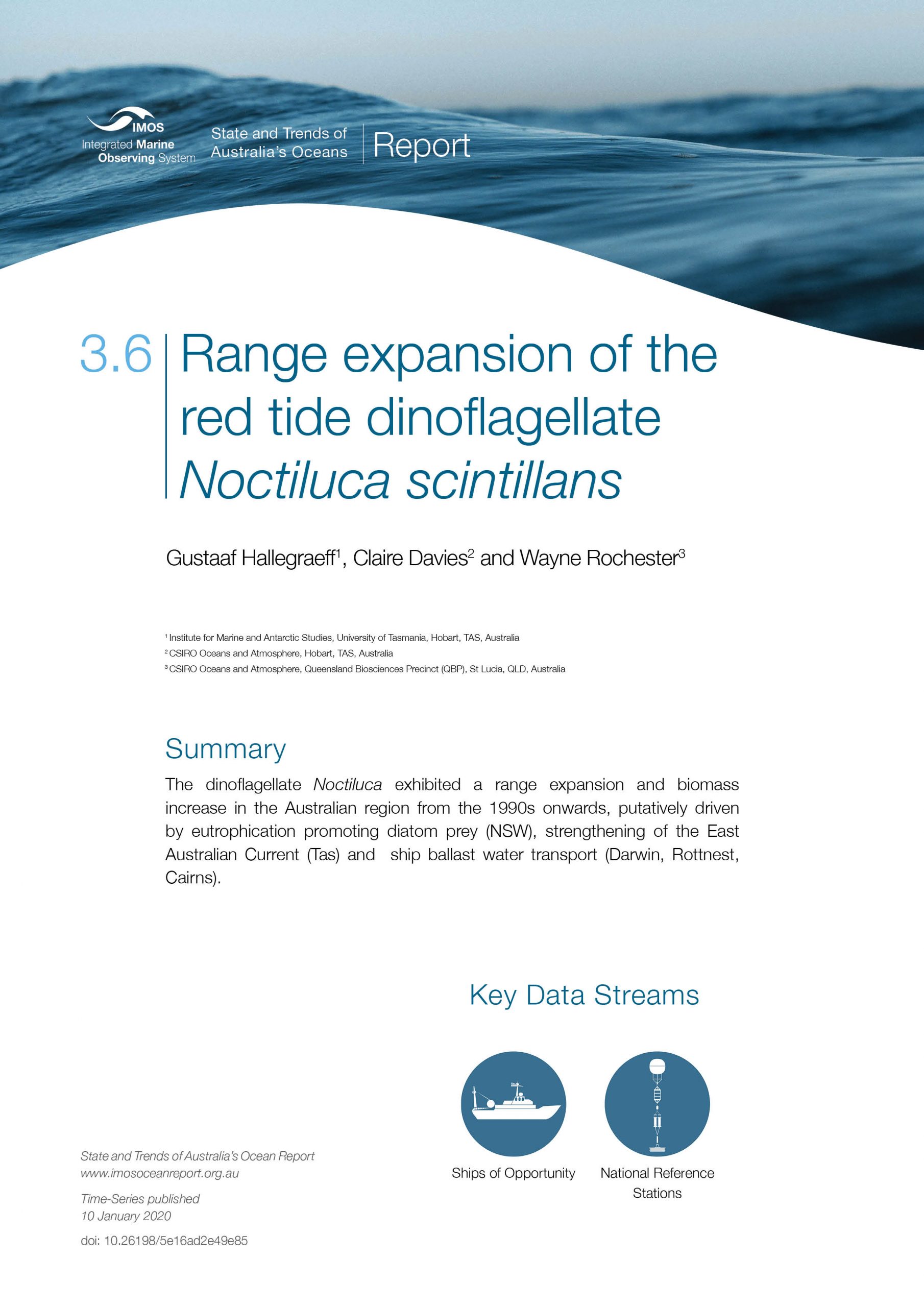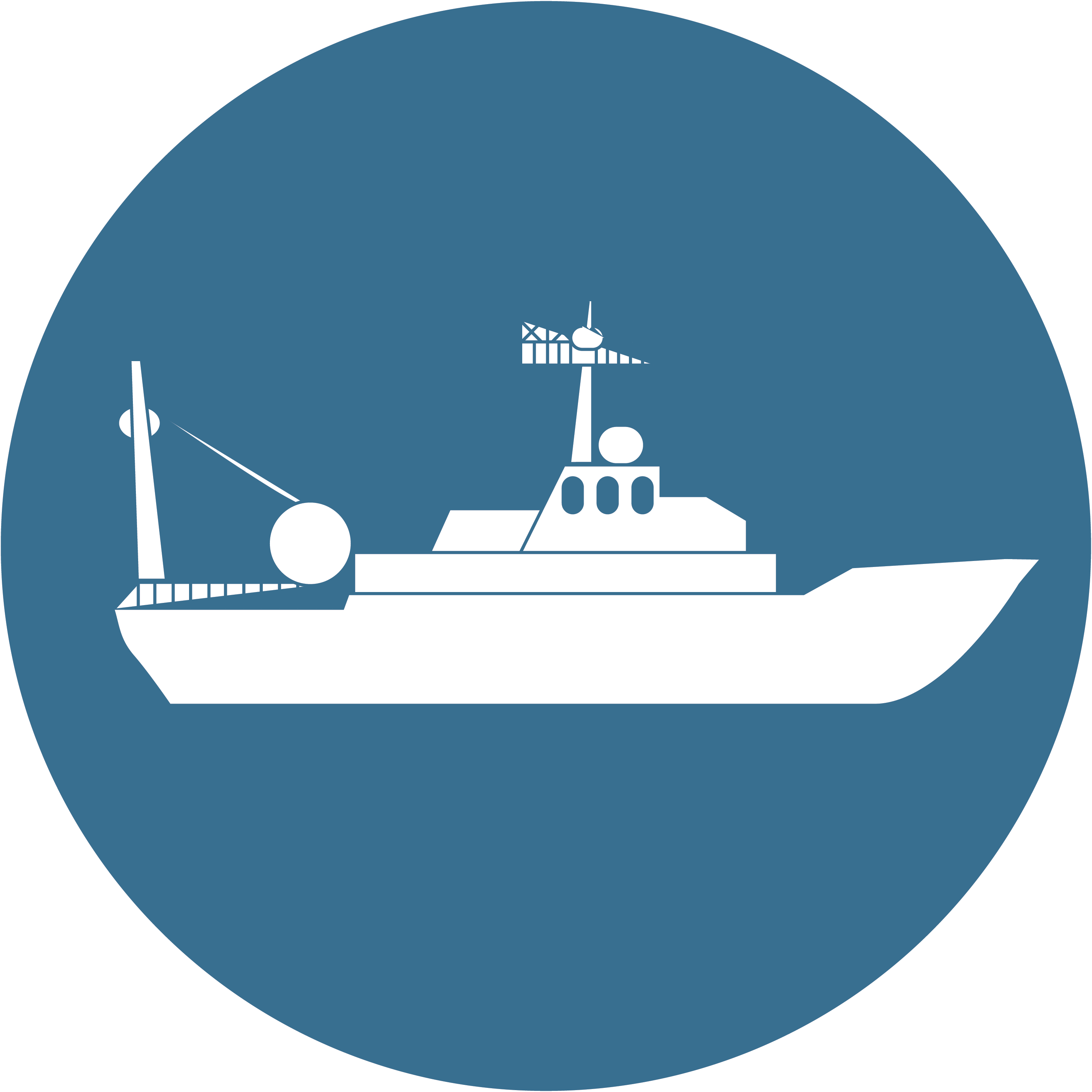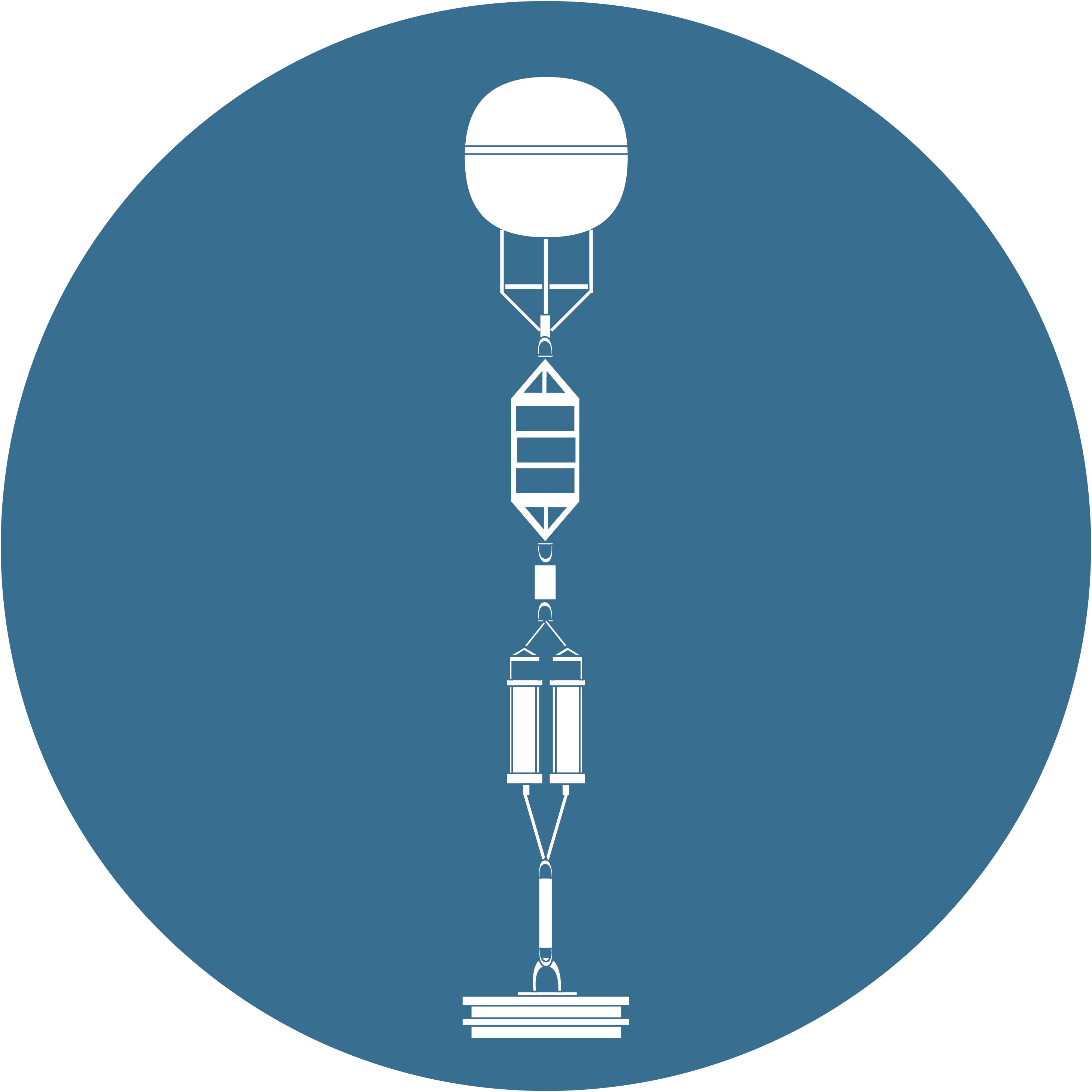Biological Time Series - Water Quality
3.6
Range expansion of the red tide dinoflagellate Noctiluca scintillans
Contributors
Gustaaf Hallegraeff1
Claire Davies2
Wayne Rochester3
1 Institute for Marine and Antarctic Studies, University of Tasmania, Hobart, TAS, Australia
2 CSIRO Oceans and Atmosphere, Hobart, TAS, Australia
3 CSIRO Oceans and Atmosphere, Queensland Biosciences Precinct (QBP), St Lucia, QLD, Australia
Key Information
The dinoflagellate Noctiluca exhibited a range expansion and biomass increase in the Australian region from the 1990s onwards, putatively driven by eutrophication promoting diatom prey (NSW), strengthening of the East Australian Current (Tas) and ship ballast water transport (Darwin, Rottnest, Cairns).
Keywords
East Australian Current, ballast water, eutrophication
Range expansion of the red tide dinoflagellate Noctiluca scintillans
Noctiluca scintillans is a conspicuous, large (200 – 1000 μm diameter) dinoflagellate that commonly forms red tide surface slicks (Figure 1) and spectacular bioluminescent spectacles. It does not photosynthesise, but ingests small cells and particles. Noctiluca was first documented in Australian waters in Sydney Harbour in 1860. Up till the end of the 1980s, it was rarely seen, but had been newly reported from Moreton Bay and the Gulf of Carpentaria. Since the 1990s, Noctiluca prevalence has changed from rarely forming blooms to now becoming one of the most prominent red-tide organisms in Sydney and Tasmanian coastal waters. This range expansion and biomass increase raises concerns for beach tourism, grazing competition with zooplankton and larval fish, and ichthyotoxicity for finfish aquaculture.
Historical observations of Noctiluca by plankton researchers, environmental agencies and the public were collated in the Australian Phytoplankton Database (Davies et al., 2017). Recent observations were drawn from the Integrated Marine Observing System (IMOS) Australian Continuous Plankton Recorder Survey, the Southern Ocean Continuous Plankton Recorder Survey, and phytoplankton and zooplankton samples from the IMOS National Reference Stations (Eriksen et al., 2019). All data were sourced from the IMOS Australian Ocean Data Network (AODN) (https://portal.aodn.org.au/; see the datasets “IMOS - AusCPR: Phytoplankton Abundance”, “Southern Ocean Continuous Zooplankton Records”, “The Australian Phytoplankton Database (1844 - ongoing) - abundance and biovolume” and “IMOS National Reference Station (NRS) - Zooplankton Abundance”).
As Noctiluca can be a voracious feeder on phytoplankton and on copepod nauplli, Noctiluca can compete with and exert predatory pressure on copepods. We thus explored whether the expansion of Noctiluca in Australian waters could be negatively impacting the abundance of copepods. For data from Port Hacking and Maria Island National Reference Stations, we explored the relationship between Noctiluca and copepod abundances by removing the climatology signal from the abundance data and comparing residual values. A negative relationship between Noctiluca abundance and copepod abundance would mean that higher abundances of Noctiluca co-occur with lower abundances of copepods, implying Noctiluca is having negative competitive and/or predatory effects on copepods.
Noctiluca scintillans has significantly expanded its distribution around Australia since the 1980s and increased its biomass (Figure 2). Noctiluca was first reported in Australia in 1860 in Sydney Harbour (Bennett, 1860). From 1950-1979, there was extensive phytoplankton sampling around Australia, but Noctiluca was only recorded in Sydney Harbour and Lake Macquarie. In the 1980s, the only new location for Noctiluca was the Gulf of Carpentaria (Burford, Rothlisberg, & Wang, 1995). Therefore, before the 1990s, Noctiluca appeared to be a rare and ephemeral species in warmer waters of Australia.
In the 1990s, Noctiluca expanded its distribution into southern NSW and Moreton Bay (Heil, M.J., Miller, & Dennison, 1998), putatively stimulated by eutrophication of coastal estuaries promoting seed populations (Dela-Cruz, Ajani, Lee, Pritchard, & Suthers, 2002). It was first observed in Tasmania in 1994, apparently carried by the East Australian Current (EAC), and has since established overwintering populations (G. Hallegraeff, Hosja, Knuckey, & Wilkinson, 2008). In 2008, IMOS sampling observed Noctiluca off Townsville in Queensland, at Esperance in Western Australia, and at Kangaroo Island in South Australia. In 2010, Noctiluca was observed in the Southern Ocean for the first time, the most southerly record globally. It was transported south by a warm-core eddy, a likely consequence of the increased poleward penetration of the EAC (McLeod, Hallegraeff, Hosie, & Richardson, 2012). In 2013, Noctiluca was observed even further south in the Southern Ocean. In 2014, Noctiluca was reported for the first time from Darwin Harbour. In 2017, Noctiluca was observed at Rottnest Island for the first time. Interestingly, a mixotrophic green Noctiluca, different to the heterotrophic form we have seen here, hosts green flagellate symbionts. Green Noctiluca forms nuisance blooms in the Arabian Sea, but has never yet been observed in Australian waters.
Noctiluca has now been found at all IMOS National Reference Stations (NRS) (see Common Methods) and is common during spring (Figure 3). There is some evidence of an increase in Noctiluca scintillans abundance at Yongala and its recent appearance at Rottnest Island is noteworthy (Figure 3). Although Port Hacking typically has the highest concentrations of Noctiluca of all the NRS, there has been a weak decline in abundance over the past 16 years. In 2017 and 2018, there was some evidence of an increase in Noctiluca scintillans abundance off South-eastern Australia from the CPR transects from Brisbane to Sydney, and Sydney to Melbourne (Figure 4). In terms of the seasonal cycle, there is a clear relationship between bloom timing and latitude, with Noctiluca blooms earlier in the year further north. Noctiluca blooms in autumn and winter in tropical Australia, in spring in the subtropics, and in summer in temperate waters (Figure 3). In Sydney waters, most Noctiluca blooms are in spring and late summer (Dela-Cruz et al., 2002) as water temperatures warm to 19-24°C, while in Tasmania although Noctiluca is present through the year, even in winter-spring at temperatures of 10-13°C, largest blooms are in summer (18-20°C).
While Noctiluca blooms are largely driven by prey availability, these seasonal responses indicate that temperature plays an important role in distribution. Acclimatised Tasmanian Noctiluca cultures under optimal conditions showed cell division at 10°C. But there was limited survival at 7°C, and Noctiluca were unable to thrive at Sydney summer temperatures of 25°C (G. M. Hallegraeff et al., submitted). This variability in temperature tolerance is supported by frequency of occurrence data from the IMOS NRS (Figure 4). While Tasmanian Noctiluca are favoured by summer temperatures, improved food availability is likely to maintain its occurrence throughout the rest of the year.
The relationship between Noctiluca and copepod abundances from Port Hacking and Maria Island National Reference Stations was positive and significant, after removing their seasonal cycles (Figure 6). This was contrary to expectations and indicates that Noctiluca is not having a negative impact on copepod populations. The positive relationship is probably a consequence of similar drivers; numbers of both Noctiluca and copepods are stimulated by greater phytoplankton abundance. The relationship was similar if total zooplankton was used in the analysis, rather than copepods.
Since the 1980s, Noctiluca has clearly expanded its geographic range and increased its bloom frequency. There are likely to be several potential mechanisms responsible for the range expansion of Noctiluca: 1. Stimulation of seed populations in estuaries by eutrophication (NSW); 2. Warmer water temperatures (southeast Australia); 3. Ship ballast water transport (WA, SA, Qld); and 4. Changes in prey abundance. Since the 1990s, waters in southern Australia have become warm enough to support Noctiluca. It can also be transported into the Southern Ocean in warm-core eddies that spin off from the EAC (McLeod et al., 2012). As the EAC is projected to continue to strengthen and transport more warm-core eddies further south, and as the Southern Ocean warms, Noctiluca may be able to establish in the Southern Ocean in the future, leading to potential competition with zooplankton grazers for phytoplankton.
Whilst Noctiluca is not having a negative effect on the abundance of copepods (Figure 6), the continued range expansion and increase in abundance of Noctiluca could have negative impacts on aquaculture and fisheries. Noctiluca has been implicated in the decline of fisheries in the Indian Ocean (Bhimachar & George, 1950) and can negatively impact caged fish production. Fortunately, compared to other fish-killing algae, the dinoflagellate Noctiluca would rank as the least ichthyotoxic. Only surface slicks of 1,000,000 to 2,000,000 cells per litre pose a risk to finfish aquaculture, both in terms of high ammonia and reduced oxygen (G. M. Hallegraeff et al., submitted). There is anecdotal evidence of shellfish tasting like ammonia in association with Noctiluca slicks and showing slower growth due to lack of phytoplankton food.
Bennett, G. (1860). Gatherings of a naturalist in Australasia: Currawong Press, Australia
Bhimachar, B. S., & George, P. C. (1950). Abrupt set-backs in the fisheries of the Malabar and Kanara coasts and “red water” phenomenon as their probable cause. Proceedings of the Indian Academy of Sciences, Series B 31, 339-350.
Burford, M. A., Rothlisberg, P. C., & Wang, Y. G. (1995). Spatial and temporal distribution of tropical phytoplankton species and biomass in the Gulf of Carpentaria, Australia. Marine ecology progress series, 118(1-3), 255-266. Retrieved from <Go to ISI>://A1995QP42600024
Davies, C. H., Coughlan, A., Hallegraeff, G., Ajani, P., Armbrecht, L., Atkins, N., . . . Richardson, A. J. (2017). A database of marine phytoplankton abundance, biomass and species composition in Australian waters. Scientific Data, 4, 170042. doi:10.1038/sdata.2017.42
Dela-Cruz, J., Ajani, P., Lee, R., Pritchard, T., & Suthers, I. (2002). Temporal abundance patterns of the red tide dinoflagellate Noctiluca scintillans along the southeast coast of Australia. Marine ecology progress series, 236, 75-88.
Eriksen, R. S., Davies, C. H., Bonham, P., Coman, F. E., Edgar, S., McEnnulty, F., . . . Richardson, A. J. (2019). Australia’s long-term plankton observations: the Integrated Marine Observing System National Reference Station network. Frontiers in Marine Science, 6(Article 161), 17.
Hallegraeff, G., Hosja, W., Knuckey, R., & Wilkinson, C. (2008). Recent range expansion of the red-tide dinoflagellate Noctiluca scintillans in Australian coastal waters. Harmful Algae News, 38, 10-11.
Hallegraeff, G. M., Albinsson, L., Dowdney, J., Holmes, A. K., Mansour, P., & Seger, A. (2019). Prey selection, environmental tolerances and ichthyotoxicity by the red-tide dinoflagellate Noctiluca scintillans cultured from Tasmanian waters. Journal of Plankton Research, 41, 407-418.
Heil, C. A., M.J., O. D., Miller, C. A., & Dennison, W. C. (1998). Phytoplankton community response to a flood event. In I. R. Tibbetts, N. J. Hall, & W. C. Dennison (Eds.), Moreton Bay and Catchment (pp. 569-584). School of Marine Science, The University of Queensland.
McLeod, D. J., Hallegraeff, G. M., Hosie, G. W., & Richardson, A. J. (2012). Climate-driven range expansion of the red-tide dinoflagellate Noctiluca scintillans into the Southern Ocean. Journal of Plankton Research, 34(4), 332-337. doi:10.1093/plankt/fbr112
Figure 1
Noctiluca red tides in Australian waters. a. Clovelly Beach, Sydney, Nov 2012, Daily Telegraph; b, c, e. Tasman Peninsula, March 2002; photos G. Hallegraeff and J. Marshall; d. Freycinet Peninsula, Feb 2004, photo: E. Watson.
Figure 2
Expansion in the distribution of Noctiluca scintillans in Australian waters from 1860-2018. Blue dots show where Noctiluca has been detected, grey circles show the sampling effort within each time period.
Figure 3
Time series (left) and seasonality (right) of Noctiluca for NRS stations. The estimated seasonal abundance used model predictions from data collected by net and Niksin bottles.
Figure 4
IMOS Continuous Plankton Recorder observations of Noctiluca from the Brisbane to Sydney and Sydney to Melbourne routes, between 2009 and early 2019.
Figure 5
Frequency of occurrence of Noctiluca at the NRS (2008 – 2018) and associated Sea Surface Temperature (SST) for each observation.
Figure 6
Noctiluca “blooms” start from small estuarine seed populations, that capitalise on feeding on dense diatom prey. Under calm stable water column conditions, Noctiluca can no longer access food and moves to surface. If successfully dispersed into new food areas, growth continues (green arrow). In the absence of feeding activity, populations die and generate red (often bioluminescent) coastal slicks (red arrow).
Figure 7
Relationship of the residual abundances of copepods to Noctiluca after removing the climatologies at a) Port Hacking and b) Maria Island National Reference stations.
Download this Time Series Report
Citing this report:
Hallegraeff G, Davies C, Rochester W. (2020) Range expansion of the red tide dinoflagellate Noctiluca scintillans. In Richardson A.J, Eriksen R, Moltmann T, Hodgson-Johnston I, Wallis J.R. (Eds). State and Trends of Australia’s Ocean Report. doi: 10.26198/5e16ad2e49e85
doi: 10.26198/5e16ad2e49e85
Citing the Report
Richardson A.J, Eriksen R, Moltmann T, Hodgson-Johnston I, Wallis J.R. (2020). State and Trends of Australia’s Ocean Report, Integrated Marine Observing System (IMOS).

The State and Trends of Australia's Ocean Report was supported by IMOS. IMOS gratefully acknowledges the additional support provided by the Commonwealth Scientific and Industrial Research Organisation (CSIRO).
The State and Trends of Australia's Ocean website is maintained by IMOS.
Australia’s Integrated Marine Observing System (IMOS) is enabled by the National Collaborative Research Infrastructure Strategy (NCRIS). It is operated by a consortium of institutions as an unincorporated joint venture, with the University of Tasmania as Lead Agent.
Disclaimer:
You accept all risks and responsibility for losses, damages, costs and other consequences resulting directly or indirectly from using this site and any information or material available from it. While the Integrated Marine Observing System (IMOS) has taken reasonable steps to ensure that the information on this website and related publication is correct, it provides no warranty or guarantee that information provided by the authors is accurate, complete or up-to-date. IMOS does not accept any responsibility or liability for any actions taken as a result of, or in reliance on, information on its website or publication. Users should check with the originating authors to confirm the accuracy of the information before taking any action in reliance on that information.
If you believe any information on this website or in the related publication is inaccurate, out of date or misleading, please bring it to our attention by contacting the authors directly or emailing us at IMOS@imos.org.au
Images and Information:
All information on this website remains the property of those who authored it. All images on this website are licensed through Adobe Stock, Shutterstock, or have permission from the original owner.
